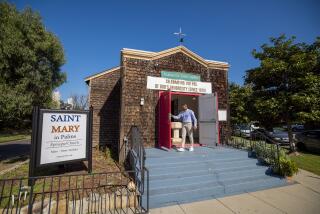Plans Would Limit ‘Tacky Homes’ : Development: The L.A. City Council adopts two controversial proposals to reduce building in the San Gabriel foothills, but one group calls them ‘racist.’
Two growth-control plans adopted Wednesday by the Los Angeles City Council were touted by Councilman Joel Wachs as a way to slow construction of “tacky homes” in the development-threatened foothills of the San Gabriel Mountains.
But the plans, approved by the council on a 14-0 vote, also were damned by some real estate interests as a “racist” attempt to keep minorities out of the hillside communities.
The two controversial community plans reduce building opportunities on thousands of hillside properties in the Sunland, Tujunga, Shadow Hills, Lake View Terrace and Sun Valley communities, according to city planning reports.
The two new plans--one for Sun Valley, the other for the four other communities--would reduce the population capacity of the affected areas from 150,000 to 129,000, the reports estimated.
“It dramatically restricts what can be developed,” Wachs said in an interview. “Yeah, if I owned the land, I’d be real upset with this. But tough luck. The developers want to desecrate the hills just to have a few more tacky homes.”
The key rollback feature of the plan adopted Wednesday involves the city’s slope-density ordinance and reduction of densities on 3,000 acres of hillside from low and very-low levels to minimum levels.
Land designated for minimum density may be developed with only one house for every one acre at the least--20 acres at the most. The number of units permitted on such land is calculated using the city’s “slope-density formula,” which requires homes on steeper slopes to be built on bigger lots.
During the council discussion, Wachs said the plans would protect a rare commodity in Los Angeles: “the California Dream” of hillside neighborhoods of natural beauty that are affordable to the “person of average means.” Unlike their counterparts in the Santa Monica Mountains, homes in the northeast San Fernando Valley’s foothill communities are relatively inexpensive.
At least temporarily spared from the plan’s sweeping rollback were seven pending development proposals in the foothills, including ones by Dale Poe for a 119-unit subdivision on 41 acres in Tujunga and by Nansay Corp. for a 63-unit, horse-keeping subdivision on a 65-acre site in Shadow Hills.
But the debate over the seven projects was only postponed, not resolved, by Wednesday’s action.
Wachs said he may very well seek to reduce the size of the seven projects by designating them for minimum densities when their specific development plans come before the council. “Absolutely--that’s very much a possibility,” Wachs said.
But approval of both plans would have been delayed Wednesday if he had tried to include the downzoning of the seven projects, Wachs said. “Each of these projects would be a lengthy and complex thing to fight,” he said. “We’ll fight these seven battles later.”
Also not affected by the plans approved Wednesday are existing legally subdivided parcels. Such parcels, no matter how small, can still have at least one home built upon them, city planners said. The slope-density provisions of the plans do not kick in unless a property owner tries to subdivide.
His support for the hillside protection plans won widespread praise for Wachs from 20 local homeowners who attended Wednesday’s council meeting.
But a local property owners group, Foothill Alliance for Informed Residents (FAIR), has claimed that the growth-control plans were not only an arbitrary attack on property rights but also “essentially racist.”
In a recent newsletter to FAIR members, the group’s president, Charlyne Pleasant, a local real estate agent, said the plan will “restrict the opportunities for minorities to own single-family homes in the foothills” by making the new homes--on bigger lots--more expensive.
But Lew Snow, a Lake View Terrace homeowner leader, denied allegations of racism in his remarks to the council as he noted that his community is already integrated, with a population that is 50% Latino and 20% black.
More to Read
Sign up for Essential California
The most important California stories and recommendations in your inbox every morning.
You may occasionally receive promotional content from the Los Angeles Times.










